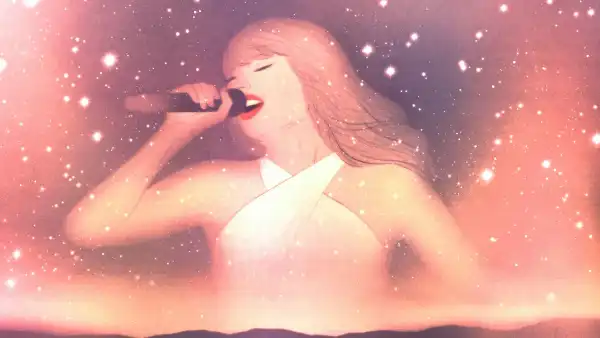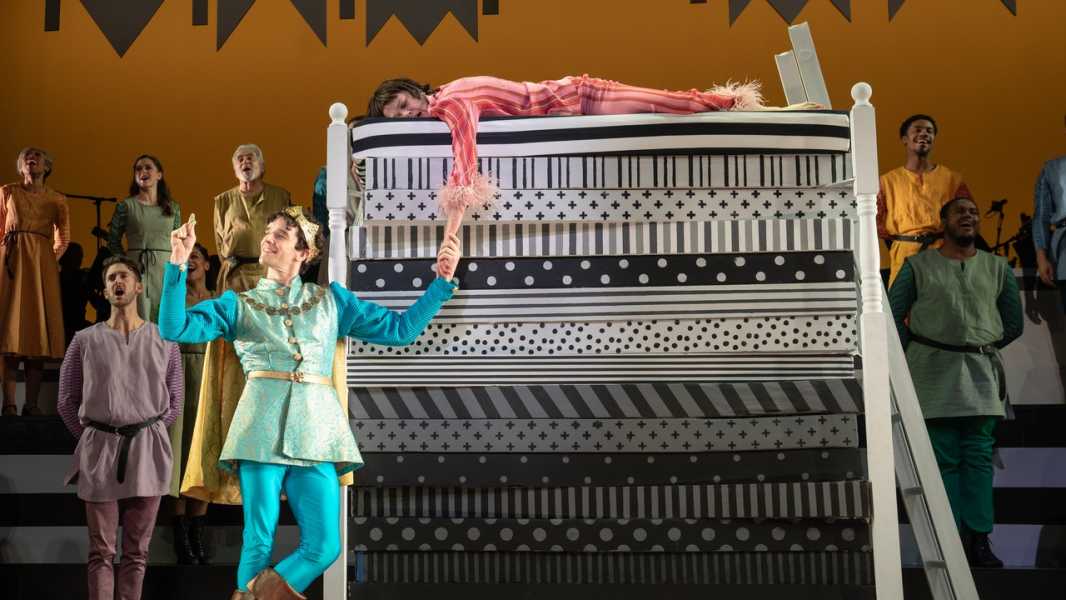
Save this storySave this storySave this storySave this story
Helen Shaw
Staff writer
You’re reading the Goings On newsletter, a guide to what we’re watching, listening to, and doing this week. Sign up to receive it in your in-box.
If you’re going to find pleasure in New York in the middle of a heat (and news) wave, you’ll need three things: loose clothing, ice cream, and the lightest of light comedies, preferably something so buoyant that it keeps your mind floating serenely above the humidity. Sweetness, silliness, and things that barely touch the skin—those are the key. It’s handy, therefore, that, starting July 31, a sorbet-colored Encores! revival of “Once Upon a Mattress,” the oddball, quasi-medieval musical frolic, from 1959, transfers over from City Center to the Hudson Theatre, on Broadway.
Amy Sherman-Palladino has adapted the book for the Broadway run; the original, a reimagined version of the princess and the pea, was written by Marshall Barer, Jay Thompson, and Dean Fuller, with lyrics by Barer and music by Mary Rodgers, the daughter of the legendary Richard. An early version of “Mattress” was knocked together by this group to serve as an entertainment at Camp Tamiment, a sort of summer camp for grownups in the Poconos, and you can still smell the late nights and campfire in its scenes. (For more of that marvellous mid-century gossip-and-woodsmoke flavor, listen to the audiobook of Mary Rodgers’s autobiography “Shy,” written with Jesse Green and read aloud by Christine Baranski.)
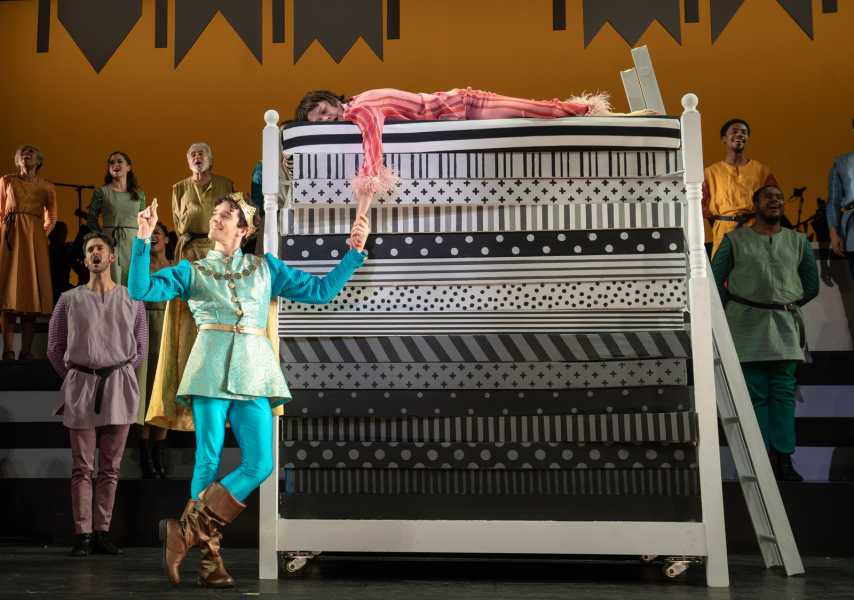
Photograph by Joan Marcus
“Mattress” is pure let’s-be-kids nonsense, with a soupçon of sex comedy: a castle is surprised when Winnifred the Woebegone—a hard-charging, beer-chugging, swamp-dwelling princess—clambers out of its moat to woo its bashful prince, Dauntless. The first Winnifred was Carol Burnett, and here Sutton Foster galumphs gleefully into Burnett’s footsteps: Foster is a vaudevillian and a champion ham, and “Mattress” lets her lean into the thousand possibilities of her rubber bones. (Michael Urie is her Dauntless, and he manages to be both wide-eyed straight man and melting ingénue at once.) Lear deBessonet, who also directed the Encores!-to-Broadway production of “Into the Woods,” in 2022, again imports the revival series’ stripped-down, concert-style fleetness. It’s the right meal for summer: eat and eat, you’ll still leave lighter than you went in.

About Town
Dance
Since 2021, five of New York City’s top dance companies—New York City Ballet, Alvin Ailey American Dance Theatre, American Ballet Theatre, Dance Theatre of Harlem, and Ballet Hispánico—have joined forces for the BAAND Together Dance Festival, at Lincoln Center. The best selections on this year’s sampler, performed indoors this time, are George Balanchine’s intimate and haunting “Duo Concertant” and William Forsythe’s spiky “Blake Works IV,” which the Harlem dancers turn into sexy fun. Also on the program: Hans Van Manen’s “Solo” (which is actually a trio) and Annabelle Lopez Ochoa’s “Sombrerísimo.”—Brian Seibert (David H. Koch Theatre; July 30-Aug. 3.)
Off Broadway
Beckett breeds strange fanboys. One is Bill Irwin, an actor and a clown who created “On Beckett,” a one-man show, from 2018, about the “famous Irish writer of famously difficult writings,” now lovingly revived. The solo format befits Beckett, renowned for his exploration of human interiority and isolation. Irwin, however—amid selections from “Waiting for Godot” and from lesser-known works such as “Texts for Nothing”—argues that underlying the alienation is a desire for meaning and connection. He makes a convincing case, bringing such extraordinary physicality to Beckett’s words that the texts draw you in, despite their abstruseness. If Irwin’s charm doesn’t always keep tedium at bay, consider it a reminder of our ongoing struggle for fulfillment in an indifferent universe.—Dan Stahl (Irish Rep; through Aug. 5.)
Hip-Hop
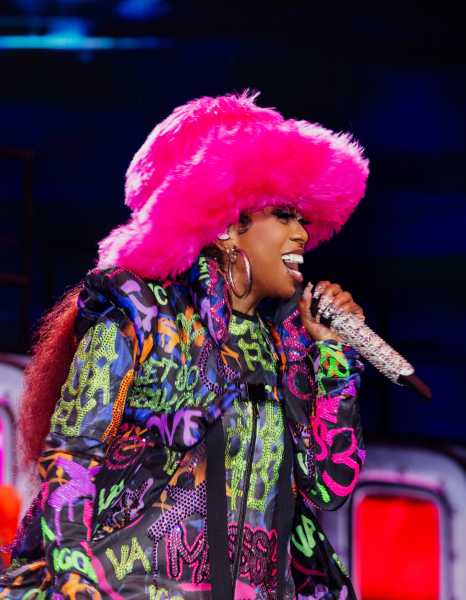
Photograph by Alexis Smith
Few musicians have been more multimedia savvy than Missy Elliott. At the turn of the millennium, the visionary Virginia rapper helped advance hip-hop forms with a future-funk sound and a freaky, animated stylistic identity, all powered by a wild and uncanny imagination. Across her four best albums, from the 1997 classic “Supa Dupa Fly” to “Under Construction” (2002), Elliott was constantly shifting, working alongside the producer Timbaland and the video directors Hype Williams and Dave Meyers, and sustained through the mid-two-thousands by flamboyant performances. She packs all of that audiovisual history into the “Out of This World” tour, her first billing as a solo headliner, supported by fixtures from throughout her career—Timbaland, the R. & B. singer Ciara, and the like-minded eccentric Busta Rhymes.—Sheldon Pearce (UBS Arena; Aug. 3.)
Classical
What travels the world but stays in one spot? It’s the venerable stamp, and also, this August, Carnegie Hall’s World Orchestra Week. “WOW!,” as the series has been appropriately dubbed, features youth ensembles from across the world for a celebration of cultural togetherness, honoring composers and works from specific corners of the globe. It kicks off with America’s own NYO2, and brings in the Africa United Youth Orchestra, the Afghan Youth Orchestra, and the National Children’s Symphony of Venezuela, among others. As for adult chaperones, the list includes Gustavo Dudamel, Isata Kanneh-Mason, Jean-Yves Thibaudet, and Masabane Cecilia Rangwanasha.—Jane Bua (Carnegie Hall; Aug. 1-7.)
Movies
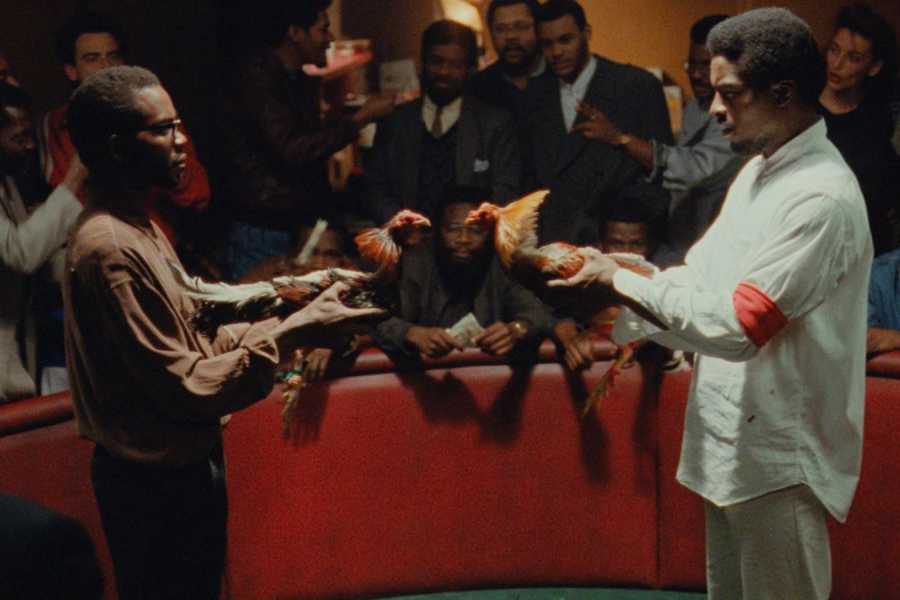
Photograph courtesy the Film Desk / Pathé
Claire Denis’s passionate and richly detailed 1990 feature, “No Fear, No Die,” now in a new restoration, is her first masterwork. It’s centered on a truck-stop complex near Paris, where the proprietor, a gangster named Pierre Ardennes (Jean-Claude Brialy), hires a duo—Jocelyn (Alex Descas), a rooster trainer, and his business partner, Dah (Isaach De Bankolé)—to run his cockfighting pit, a major gambling operation. Dah and Jocelyn are Black; Ardennes, who is white, inflicts virtually colonialist oppressions on his partners in crime. The story is told from Dah’s perspective, as Jocelyn—who displays a quasi-mystical rapport with fighting cocks—suffers an emotional breakdown, putting their business and their lives in danger. Denis films with documentary-like attention to the criminal enterprise and to the psychology of racialized power.—Richard Brody (BAM Rose Cinemas.)
Art
Though Diamond Stingily has built a solid career based on installations that conjure so much—autobiography, media, the impression bodies make on surfaces—at times her work feels not fully born, but almost there. “Diamond Stingily: Orgasms Happened Here,” taking its title from a sticky note that the artist’s brother had found in their new home, includes constructed closets and windows that evoke lives glimpsed through half-open doors, prompting horror-movie dread. Some of the closets have “nice” wallpaper and stacks of towels, while a baseball bat leans nearby: a safeguard against the violence that families of color experience day after day. In her wonderfully creepy work, this still evolving artist asks, How does a family enter a home, make a home?—Hilton Als (52 Walker; through Sept. 14.)

Illustration by Joost Swarte
Bar Tab
Jiayang Fan visits a James Baldwin-themed bar.

Illustration by Claire Merchlinsky
Few who step into Another Country (10 E. 16th St.), a retro lounge near Union Square, would guess that it was named for James Baldwin’s 1962 novel of Black rage, urban malaise, and the tantalizing torment of love. True, the surroundings—low ceilings, oak panelling, muted pink banquettes—vaguely evoke the mid-century, but otherwise the modishly minimalist bar energetically surfs the mix-and-match, exuberance-over-coherence vibes of 2024. There, too, is the matter of how Another Country bills itself: as a vinyl bar, where you may be forgiven for expecting jazz (the novel’s protagonist is a tortured jazz musician). But on a recent Wednesday night all that two first-timers could hear was other people’s conversations. They found out from a genial server that the music they were missing wasn’t any of the albums displayed behind the bar but the server’s Spotify list (less Coltrane, more British post-punk). Disoriented, the pair perused the menu, he choosing C’mon Dad Gimme the Car, a tequila-forward, lip-tickling strawberry-and-jalapeño cocktail named for a Violent Femmes song, she opting for I May Destroy You, a smoky mezcal-and-Aperol number inspired by the HBO show. The spirit-free category (“more popular with the younger crowd,” the server explained) listed The Beautiful and The Damned. Were they named, ironically, after the Fitzgerald novel? The woman wanted to ask the bartender, but her companion reminded her how perilously close she was to ruining the experience for everyone within earshot, including the young couple next to them, who exchanged thoughts on the best things they did in the last month (travel to Mykonos, try Hailey Bieber’s TikTok-viral “Strawberry Glaze Skin” smoothie). “Except for a lucky few,” the bartender hissed, “everyone here is just trying to survive their first date.”
P.S. Good stuff on the Internet:
- “Just take it”—words to live by
- How do celebrity book clubs actually work?
- Samantha Williams sings “Poetry”
Sourse: newyorker.com


